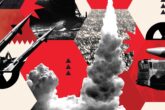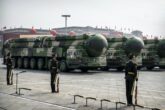December 01, 2021
Who’s to Blame for Asia’s Arms Race?
China’s military buildup is undeniable. It has built hundreds of long-range and precise ballistic missiles, launching them for years at mockups of U.S. ships and bases in Asia. It has constructed the world’s largest navy in terms of the number of ships, vastly exceeding the U.S. Navy’s rate of warship production in recent years. As Beijing has grown stronger, it has also become increasingly belligerent: it bullies neighbors that have had the temerity to use their own natural resources, and its state-controlled media routinely threaten Taiwan with invasion.
But in “America Is Turning Asia Into a Powder Keg” (October 22), Van Jackson argues that an “overly militarized” U.S. approach is to blame for increasing the risk of war and worsening negative regional trends. Although Jackson concedes that Washington is not “the cause of these troubling trends,” and “should not be blamed for the actions of China and North Korea,” his article leaves the opposite impression. Furthermore, he makes his case by presenting facts that are at times misleading, mischaracterized, or inaccurate. He portrays as recklessness what is in fact a rational U.S. and allied response to a dramatic expansion of China’s offensive military capabilities.
As Beijing has grown stronger, it has also become increasingly belligerent.
Jackson starts by blaming Washington for “surging troops and military hardware into the region.” Although there have been a number of initiatives to “pivot to the Pacific” and rebalance the U.S. military toward Asia, the change in American troop presence has not been as dramatic as this rhetoric suggests. According to the Pentagon’s personnel records, roughly 89,000 U.S. active-duty troops were stationed in the Indo-Pacific theater as of this summer. A decade ago, the number was about 84,000. An increase of 5,000 troops, constituting less than half a percent of the U.S. armed forces’ personnel, does not constitute a “surge” that is aggravating tensions in the region, even if one takes into account the few thousand additional soldiers that are likely present at any time on rotational missions.
Jackson also blames the administration of U.S. President Joe Biden for embarking on defense initiatives that he claims escalate an arms race with China. He cites its encouragement of Japan to develop hypersonic weapons (a program that was unveiled in March 2020, ten months before Biden’s inauguration) and extend the range of its antiship missiles (also begun in 2020). He further states that the administration has announced plans for an expanded presence in Guam—reference to the ongoing move of 5,000 U.S. Marines to Guam from Okinawa, Japan (farther away from China), which has been planned since 2006. Finally, he mentions a new base in Papua New Guinea—actually an upgrade of an existing base, which was announced in 2018—and new radars in Palau, which lie more than 1,500 miles from China and whose arrival was first announced in 2017. These policies to counter China’s growing military threat should not be attributed solely to Biden’s team; instead, they represent a cross-administration and bipartisan effort to cope with the clear reality of a rapidly deteriorating military balance.
Read the full article from Foreign Affairs.
More from CNAS
-
There Are No Magic Beans: Easy Options to Deter China Militarily Do Not Exist
The only assured way to deter an attack on Taiwan is to have sufficient survivable forces and munitions properly postured before a Chinese attack....
By Tom Shugart
-
Over the Brink
Executive Summary A new era of nuclear deterrence is taking shape in the Indo-Pacific theater. As the People’s Republic of China (PRC) dramatically expands and modernizes its ...
By Andrew Metrick, Philip Sheers & Stacie Pettyjohn
-
Into the unknown: Managing conventional and nuclear uncertainty in the Indo-Pacific
Rather than dismiss, ignore, or overlook conventional-nuclear integration discussions, US operational leaders must understand that China’s nuclear future is dangerous and unce...
By Andrew Metrick & Philip Sheers
-
Swarms over the Strait
Executive Summary Drones have transformed battlefields in Libya, Nagorno-Karabakh, and Ukraine, but in a companion report, Evolution Not Revolution: Drone Warfare in Russia’s ...
By Stacie Pettyjohn, Hannah Dennis & Molly Campbell




